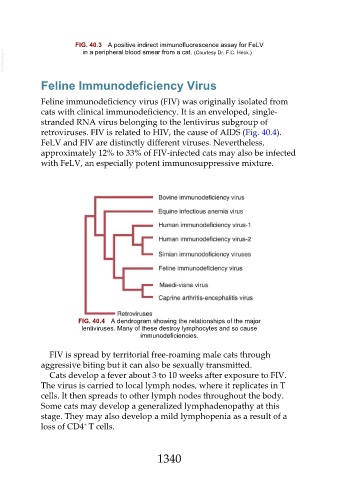Page 1340 - Veterinary Immunology, 10th Edition
P. 1340
FIG. 40.3 A positive indirect immunofluorescence assay for FeLV
VetBooks.ir in a peripheral blood smear from a cat. (Courtesy Dr. F.C. Heck.)
Feline Immunodeficiency Virus
Feline immunodeficiency virus (FIV) was originally isolated from
cats with clinical immunodeficiency. It is an enveloped, single-
stranded RNA virus belonging to the lentivirus subgroup of
retroviruses. FIV is related to HIV, the cause of AIDS (Fig. 40.4).
FeLV and FIV are distinctly different viruses. Nevertheless,
approximately 12% to 33% of FIV-infected cats may also be infected
with FeLV, an especially potent immunosuppressive mixture.
FIG. 40.4 A dendrogram showing the relationships of the major
lentiviruses. Many of these destroy lymphocytes and so cause
immunodeficiencies.
FIV is spread by territorial free-roaming male cats through
aggressive biting but it can also be sexually transmitted.
Cats develop a fever about 3 to 10 weeks after exposure to FIV.
The virus is carried to local lymph nodes, where it replicates in T
cells. It then spreads to other lymph nodes throughout the body.
Some cats may develop a generalized lymphadenopathy at this
stage. They may also develop a mild lymphopenia as a result of a
+
loss of CD4 T cells.
1340

